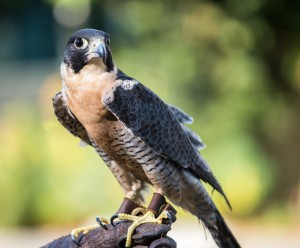Peregrine Falcon
Peregrine Falcon
Falco peregrinus
 Peregrine Falcons are found worldwide. They are the largest of the four species of falcons commonly found in California (Peregrine Falcon, Prairie Falcon, Merlin and American Kestrel). They can be identified by their narrow pointed wings, dark eyes and dark “hood” over their head and neck. They prefer open habitats such as grasslands near tall cliffs, or pseudo-cliffs such as tall city buildings for nesting. Especially during breeding season, they are noisy birds and can often be heard calling to each other.
Peregrine Falcons are found worldwide. They are the largest of the four species of falcons commonly found in California (Peregrine Falcon, Prairie Falcon, Merlin and American Kestrel). They can be identified by their narrow pointed wings, dark eyes and dark “hood” over their head and neck. They prefer open habitats such as grasslands near tall cliffs, or pseudo-cliffs such as tall city buildings for nesting. Especially during breeding season, they are noisy birds and can often be heard calling to each other.
They are considered the fastest animal on the planet – they have been recorded at 240 miles per hour while diving! Peregrine Falcons are only beat in speed by the Prairie Falcon in level flight. They use their speed and talons to catch prey, mostly other birds, in flight. Prey is killed by the talons or by the breaking of the vertebrae with the notch in their upper beak.
Peregrine Falcons were one of the first animals on the Endangered Species list, mostly due to the use of the pesticide DDT. They have had an incredible human-assisted recovery and were removed from the federal endangered species list in 1999.
Our Peregrine Falcon, Flash, was found as a juvenile in 2013 and was treated at the Wildlife Care Center of the Audubon Society of Portland (Oregon) for a broken wing. Despite surgery and lengthy rehabilitation efforts, the fracture to his right wing did not heal correctly. He cannot fully extend that wing, making him non-flighted and non-releasable. He came to live at Lindsay Wildlife in 2015 and has adjusted well to life here. He has a good appetite and can often be heard making his signature boisterous calls when he is working with his keepers.
Keepers are currently working on desensitizing Flash to voluntarily wearing a wing guard to help keep the primary feathers on his injured wing healthy. Due to his injury, the feathers will grow incorrectly and easily break.
